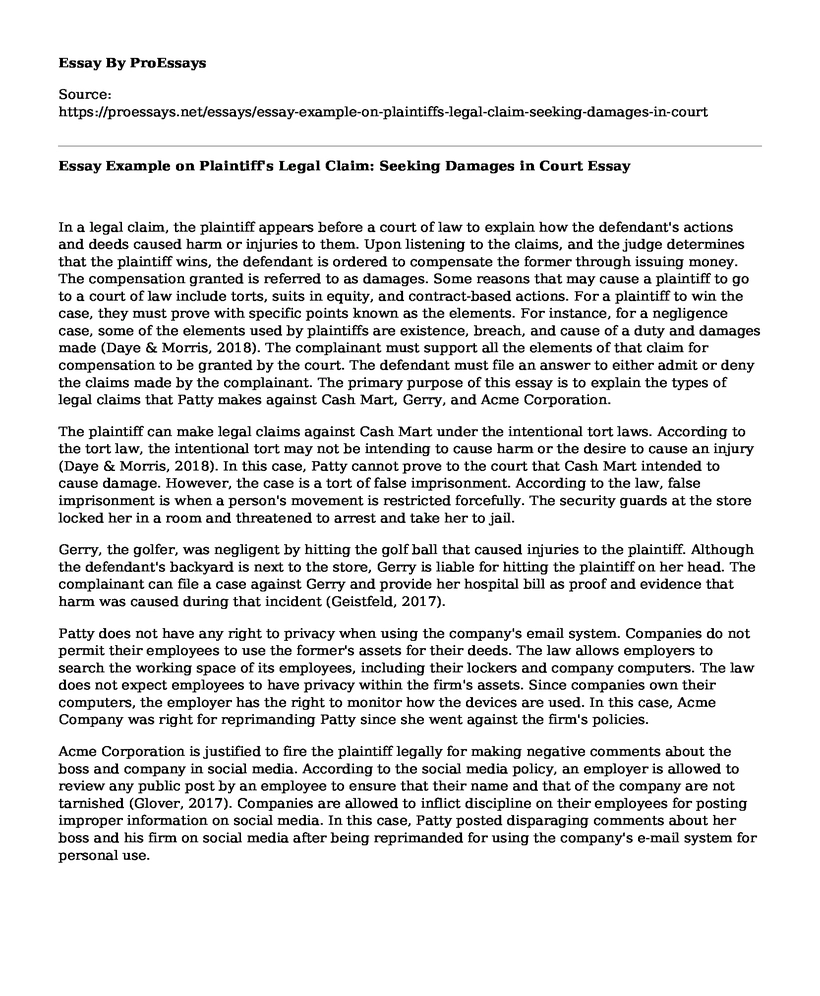In a legal claim, the plaintiff appears before a court of law to explain how the defendant's actions and deeds caused harm or injuries to them. Upon listening to the claims, and the judge determines that the plaintiff wins, the defendant is ordered to compensate the former through issuing money. The compensation granted is referred to as damages. Some reasons that may cause a plaintiff to go to a court of law include torts, suits in equity, and contract-based actions. For a plaintiff to win the case, they must prove with specific points known as the elements. For instance, for a negligence case, some of the elements used by plaintiffs are existence, breach, and cause of a duty and damages made (Daye & Morris, 2018). The complainant must support all the elements of that claim for compensation to be granted by the court. The defendant must file an answer to either admit or deny the claims made by the complainant. The primary purpose of this essay is to explain the types of legal claims that Patty makes against Cash Mart, Gerry, and Acme Corporation.
The plaintiff can make legal claims against Cash Mart under the intentional tort laws. According to the tort law, the intentional tort may not be intending to cause harm or the desire to cause an injury (Daye & Morris, 2018). In this case, Patty cannot prove to the court that Cash Mart intended to cause damage. However, the case is a tort of false imprisonment. According to the law, false imprisonment is when a person's movement is restricted forcefully. The security guards at the store locked her in a room and threatened to arrest and take her to jail.
Gerry, the golfer, was negligent by hitting the golf ball that caused injuries to the plaintiff. Although the defendant's backyard is next to the store, Gerry is liable for hitting the plaintiff on her head. The complainant can file a case against Gerry and provide her hospital bill as proof and evidence that harm was caused during that incident (Geistfeld, 2017).
Patty does not have any right to privacy when using the company's email system. Companies do not permit their employees to use the former's assets for their deeds. The law allows employers to search the working space of its employees, including their lockers and company computers. The law does not expect employees to have privacy within the firm's assets. Since companies own their computers, the employer has the right to monitor how the devices are used. In this case, Acme Company was right for reprimanding Patty since she went against the firm's policies.
Acme Corporation is justified to fire the plaintiff legally for making negative comments about the boss and company in social media. According to the social media policy, an employer is allowed to review any public post by an employee to ensure that their name and that of the company are not tarnished (Glover, 2017). Companies are allowed to inflict discipline on their employees for posting improper information on social media. In this case, Patty posted disparaging comments about her boss and his firm on social media after being reprimanded for using the company's e-mail system for personal use.
Conclusion
In conclusion, the primary purpose of this essay is to explain the types of legal claims that Patty makes against Cash Mart, Gerry, and Acme Corporation. The plaintiff can make legal claims against Cash Mart under the intentional tort laws. Gerry, the golfer, was negligent by hitting the golf ball that caused injuries to the plaintiff. Patty does not have any right to privacy when using the company's email system. Acme Corporation is justified to fire the plaintiff legally for making negative comments about the boss and company in social media.
References
Daye, C. E., & Morris, M. W. (2018). North Carolina Law of Torts. LexisNexis.
Geistfeld, M. A. (2017). Conceptualizing the Intentional Torts. Journal of Tort Law, 10(2).
Glover, J. M. (2017). A regulatory theory of legal claims. Vand. L. Rev., 70, 221.
Cite this page
Essay Example on Plaintiff's Legal Claim: Seeking Damages in Court. (2023, Jan 11). Retrieved from https://proessays.net/essays/essay-example-on-plaintiffs-legal-claim-seeking-damages-in-court
If you are the original author of this essay and no longer wish to have it published on the ProEssays website, please click below to request its removal:
- Children's Online Privacy Protection Essay Example
- The Ministry of Transportation in Canada Paper Example
- Case Study on Tennessee v. Garner
- Essay on Affordable Healthcare Act: Healthcare System Reforms & Overhauls
- 2nd Amendment Blocks Sensible Gun Laws: Confiscation Unviable - Essay Sample
- Essay Sample on Prisons Face Healthcare Crisis: Prisoners Deserve Better
- Essay on Religion in the US: The Conflict between the First Amendment and Public Schools







